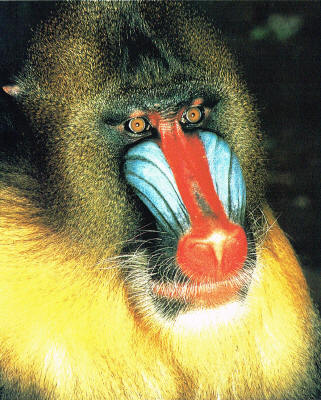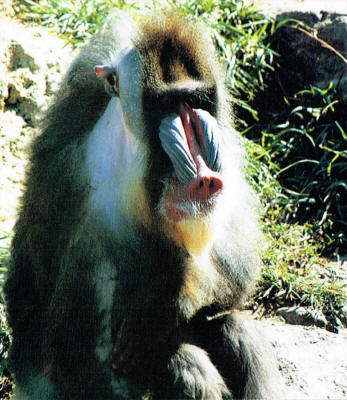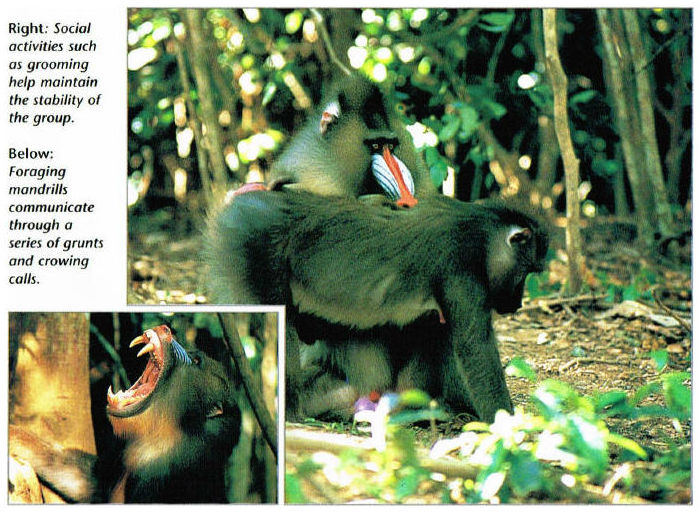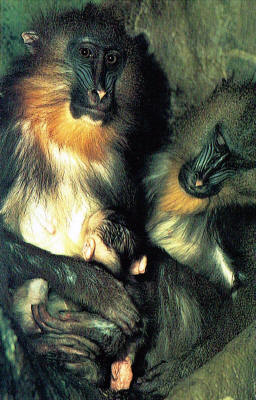|
Mandrill

The ferocious
appearance of the mandrill is misleading.
By nature, it is quite
peaceable and social.
The brilliant
coloring
of the male's face distinguishes it from the
plainer female.
|
|

Active by day
in the dense rainforests of western
and central Africa, the mandrill is one of the
largest
of the ground-dwelling baboons.
Only the adult
males have the brilliant coloration
that
has made the species so well known.
|
HABITS
Like other species of baboon, mandrills are sociable animals, living in
groups which may number from fifteen to 200 members. Each group
contains at least one adult male, five or more adult females, and their
young. Some males live alone, which indicates the likelihood of
rivalry between adult males for the leadership of groups.
Mandrills spend most of the day foraging in the forest for food.
While foraging, the animals keep in verbal contact with one another by
making grunting and crowing sounds. They also alert one another to
possible predators, such as leopards or snakes.
At intervals during the day, the group will rest. Adults groom
each other while the young play.
|
|

|
BREEDING
The dominant male has access to all the females in his harem, and he is
most likely to father offspring. He mates randomly with the females
when they are in
estrus. During
estrus, the female's sex organs become swollen, indicating that she is
ready to mate.
A single
young is born 7 months later. It suckles the mother's milk and
travels everywhere with her, clinging tightly to her chest.
Gradually, the young mandrill will begin to explore its surroundings.
Female mandrills
usually remain in the group into which they were born, but as the young
males reach maturity, they must often leave the group.
|

A female mandrill suckles her offspring. Within
hours of its birth, the young mandrill can cling
tightly to its mother's chest. As the young grow
older, they play together, which is how they learn
the skills they will need to survive in later life.
|
FOOD &
FEEDING
Mandrills eat fruits,
leaves, roots, seeds, insects, eggs, and small animals. Led by the
adult males, they begin foraging for food after daybreak.
They find
much of their food on the ground under stones and among vegetation.
Fruit trees are
another source of food for the mandrill. Large groups of mandrills,
together with other species of monkey, will converge on the trees and feed
on the fruit. Within their home range, mandrills are alert to the
seasonal sources of food.
The mandrill is adept
at foraging for food because its fingers work in a coordinated fashion.
The mandrill can dig, sort, prepare food, and transfer it to its mouth.
|
DID YOU KNOW?
●
The
mandrill is the largest of all monkeys.
● The
mandrill's reputation for ferocity is exaggerated. When a mandrill
bares its teeth, it is not threatening to attack, but rather showing
a submissive behavior.
●
Mandrills
sometimes feed on items that other monkeys have dropped from the
trees.
●
Mandrills walk on their fingers
and toes, so that the palms of their
hands and the soles of their feet do not touch the ground.
●
A
group of mandrills typically roams
over 5 miles a day while foraging for food. Their actual range may
cover as much as 20 square miles.
|
|

|


![]()
![]()